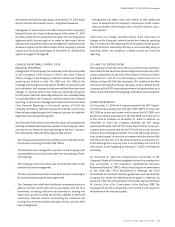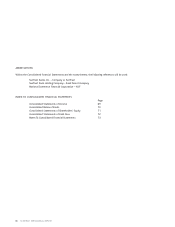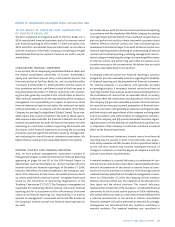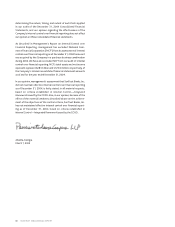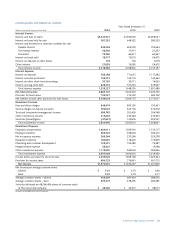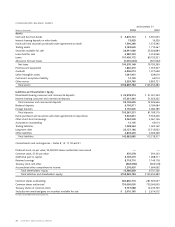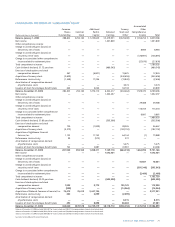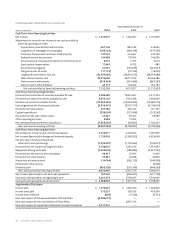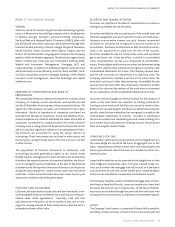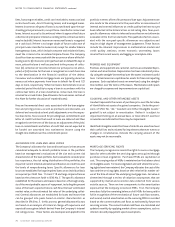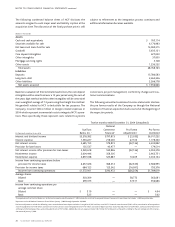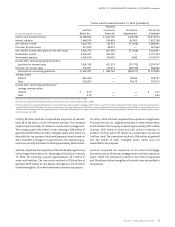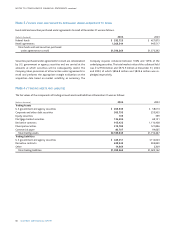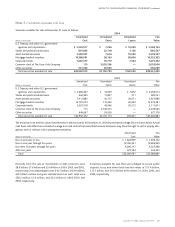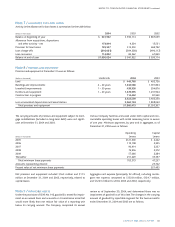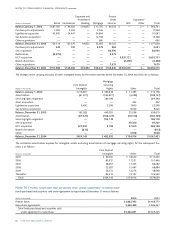SunTrust 2004 Annual Report Download - page 77
Download and view the complete annual report
Please find page 77 of the 2004 SunTrust annual report below. You can navigate through the pages in the report by either clicking on the pages listed below, or by using the keyword search tool below to find specific information within the annual report.
NOTES TO CONSOLIDATED FINANCIAL STATEMENTS continued
SUNTRUST 2004 ANNUAL REPORT 75
Impairment for MSRs is determined based on the fair value of the
rights, stratified according to interest rate and type of related loan.
Impairment, if any, is recognized through a valuation allowance
with a corresponding charge recorded in the income statement.
LOAN SALES AND SECURITIZATIONS
The Company sells residential mortgages and other loans and has
securitized mortgage loans. Retained interests in securitized assets,
including debt securities, are recorded as securities available for sale
at their allocated carrying amounts based on the relative fair value
of assets sold and retained. Retained interests are subsequently
carried at fair value, which is generally estimated based on the pres-
ent value of expected cash flows, calculated using management’s
best estimates of key assumptions, including credit losses, loan
repayment speeds and discount rates commensurate with the risks
involved. Gains or losses on sales as well as servicing fees are
recorded in noninterest income.
INCOME TAXES
The provision for income taxes is based on income and expense
reported for financial statement purposes after adjustment for per-
manent differences such as tax-exempt income. Deferred income
tax assets and liabilities result from differences between assets and
liabilities measured for financial reporting purposes and for income
tax return purposes. These assets and liabilities are measured using
the enacted tax rates and laws that are currently in effect.
Subsequent changes in the tax laws will require adjustment to these
assets and liabilities with the cumulative effect included in the cur-
rent year’s income tax provision. Recognition of deferred tax assets
is based on management’s belief that it is more likely than not that
the tax benefit associated with certain temporary differences and
tax credits will be realized. A valuation allowance would be
recorded for the amount of the deferred tax item for which it is
more likely than not that realization will not occur. The Company
periodically evaluates the merits and risks of its income tax posi-
tions based on current legislative, judicial, and regulatory guidance.
Based on this evaluation, changes are recorded as appropriate.
EARNINGS PER SHARE
Basic earnings per share are based on the weighted-average number
of common shares outstanding during each period. Diluted earn-
ings per share are based on the weighted-average number of com-
mon shares outstanding during each period, plus common shares
calculated for stock options and performance restricted stock out-
standing using the treasury stock method.
CASH FLOWS
For purposes of reporting cash flows, cash and cash equivalents
include only cash and due from banks, interest-bearing deposits in
other banks and funds sold and securities purchased under agree-
ments to resell with an original maturity of three months or less.
DERIVATIVE FINANCIAL INSTRUMENTS
It is the policy of the Company to record all derivative financial
instruments at fair value in the financial statements. The Company
uses derivative instruments to hedge interest rate exposure by
modifying the characteristics of the related balance sheet instru-
ments. Derivatives that do not qualify as hedges,and those transac-
tions for which the Company has elected not to adopt hedge
accounting, are carried at their current market value on the balance
sheet and changes in their fair value are recorded as trading income
in the current period.
Under the provisions of SFAS No. 133, “Accounting for Derivative
Instruments and Hedging Activities,” and SFAS No. 149,“Amend-
ment of Statement 133 on Derivative Instruments and Hedging
Activities,” on the date that a derivative contract is entered into,the
Company prepares written hedge documentation, identifying the
risk management objective, and designating the derivative as (1) a
hedge of the fair value of a recognized asset or liability or of an
unrecognized firm commitment (fair value hedge); (2) a hedge of a
forecasted transaction or of the variability of cash flows to be
received or paid related to a recognized asset or liability (cash flow
hedge); (3) a foreign currency fair value or cash flow hedge (foreign
currency hedge); or (4) held for trading (trading instruments). All
transactions designated as accounting hedges must first be deemed
effective using the correlation method. Additionally, transactions
which do not qualify for the shortcut method of hedge accounting
are reviewed quarterly for ongoing effectiveness. Transactions
which are not deemed effective are removed from accounting
hedge classification.
Changes in the fair value of a derivative that is highly effective, and
that has been designated and qualifies as a fair value hedge, along
with the loss or gain on the hedged asset or liability that is attribut-
able to the hedged risk (including losses or gains on firm commit-
ments), are recorded in current period earnings. Changes in the fair
value of a derivative that is highly effective, and that is designated
and qualifies as a cash flow hedge, are recorded in other compre-
hensive income, with any ineffective portion recorded in current
period earnings.Cash flow hedges of forecasted transactions, which
are no longer deemed likely to occur, are reclassified out of other
comprehensive income and into current period interest income or
expense related to the originally hedged item. Changes in the fair
value of derivative trading instruments are reported in current
period earnings. For additional information on the Company’s deriv-
ative activities, refer to Note 17 to the Consolidated Financial
Statements.
STOCK-BASED COMPENSATION
The Company sponsors stock option plans under which incentive
and nonqualified stock options may be granted periodically to cer-
tain employees. The Company’s stock options typically have an
exercise price equal to the fair value of the stock on the date of the
grant and typically vest over three years.The Company accounts for
all awards granted after January 1, 2002 under the fair-value recog-
nition provisions of SFAS No. 123, “Accounting for Stock-Based
Compensation.” The required disclosures related to the Company’s


